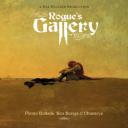 I've always been a fan of shipwrecks, pirates, lost treasure, early exploration, and the history of Earth in general. There are times when I find myself purchasing obscure documents and historical periodicals in the hope of finding something curiously unique.
I've always been a fan of shipwrecks, pirates, lost treasure, early exploration, and the history of Earth in general. There are times when I find myself purchasing obscure documents and historical periodicals in the hope of finding something curiously unique.Typically the most interesting articles are found in thick history tomes or defunct magazines such as Great Battles and Lost Fortunes. Imagine my surprise, then, to find a "Lost Treasures" article in an issue of childrens magazine Disney Adventures dated January of 1994.
The magazine quizzed three top treasure aficionados on what shipwreck would be the most valuable if found. These people included Marco Meniketti, the project director of San Agustin Institute of Marine Technology; Denise Lakey, marine archaeologist; and Jim Lima, marine historian.
The following text is taken straight from the article:
La Gallega - Sank in a Panama River, 1503.
The Treasure - a priceless Christopher Columbus ship.
Columbus was on his fourth and final trip to the Americas when he sailed up a Central American river he called Rio Belen for rest and to resupply. He and his men were attacked on shore by natives; Columbus and his crew made it to another ship but had to leave La Gallega behind. Shipwreck hunters simply can not find this wreck.
Las Cinque Chagas - Sank in the North Atlantic off the coast of the Azores, 1594.
The Treasure - 1,000 tons of spices, silk, gold, and jewels worth $500 million.
Las Cinque Chagas, one of the richest Portuguese treasure ships, was returning from India when she was attacked by English warships; only 13 people out of 1,000 survived. They were spared from execution by flashing jewels at the English sailors in return for rescue. Why hasn't anyone found the ship? No one knows where she went down.
San Jose - Sank off the Columbia coast, 1708.
The Treasure - Gold coins worth about $30 million.
This is the Big One: the richest Spanish galleon ever lost in the Western Hemisphere. The San Jose was bound for Spain from South American. She was nearing Isla del Tesoro ("treasure island") off the coast of Columbia when she was attacked and blown up by English warships. She's 2,000 feet below the ocean, too far down to get to - even if anyone knew where to look.
Grosvenor - Sank off the coast of South Africa, 1782.
The Treasure - Gold bars, gold coins, 19 chests full of jewels, and a jewel-encrusted gold throne called the "Peacock Throne of India" worth $10 million.
You'd think a 729-ton ship would be hard to wreck, but the captain did just that: he got lost, took a wrong turn, and ran the Grosvenor up a reef. The shark-infested waters - the world's most dangerous - keep treasure hunters away.
Yankee Blade - Sank off Point Arguello, California, 1854.
The Treasure - Gold Rush booty.
During the California Gold Rush, the Yankee Blade ferried food, supplies, and gold miners up and down the West Coast. On one trip, she drifted into a fog and hit a reef. Water rushed in from a 30-foot gash in her bottom, and she sank two days later. All the ship's gold is said to lie in a rusty steel vault that went down with her. Today, heavy currents and year-round bad weather keep the treasure hunters away.
I hope to eventually confirm the veracity of these accounts, and discover if any of these vessels have been at least partially located in the fourteen years since this article was published.
We shall see!

John C. Reilly "My Son John" from Rogue's Gallery (2006)
Bryan Ferry "The Cruel Ship's Captain" from Rogue's Gallery (2006)
No comments:
Post a Comment